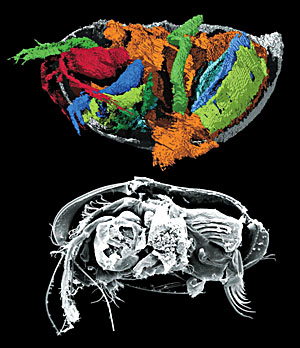 | Scientists used a shave-and-photograph technique to develop these three-dimensional images of the creature. |
Scientists have discovered a very well preserved, ocean-dwelling creature from 425-million-year-old rocks in the United Kingdom that may be the world's oldest fossil animal that is definitively male, according to a study published this week in Science.
The fossil record is packed with shells from this group of arthropods. The "ostracodes," fossilized soft parts such as those discovered by a group of researchers that included Yale scientist Derek Briggs, are extremely rare.
"The ostracodes are important for two reasons," says Briggs, professor of geology and geophysics and one of the principal investigators of the study. "They give us insights about crustacean evolution, and they're widely used to work out the age of rock sequences."
The finding pushes back the earliest described evidence for soft-tissue anatomy of this important group of living crustaceans by nearly 200 million years, say the researchers. Ostracode appendages, soft parts that protrude from the gap between its two hinged shells, suggest that the creature swam and scavenged for food along the ocean floor.
The authors cracked open the rock with the embedded creature and embarked on a shave-and-photograph technique that yielded a virtual fossil with extraordinarily preserved three-dimensional details. The five-millimeter long fossil is remarkably similar to some modern ostracodes, say the scientists, who note that this likeness suggests an extremely low rate of evolutionary change over the last 425 million years.
The researchers have called the new species "Colymbosathon ecplecticos."
"It's a nice example of very slow evolutionary change, reflected in a very conservative morphology over a long period of time," Briggs says.
Co-authors included David Siveter of Leicester and Mark Sutton and Derek Siveter, both of Oxford University.
-- By Jacqueline Weaver
T H I S
Scientists find oldest definitively male fossil
 W E E K ' S
W E E K ' S S T O R I E S
S T O R I E S![]()
 John Pepper named V.P. for Finance & Administration
John Pepper named V.P. for Finance & Administration![]()
![]()
 Yale expands Homebuyer Program
Yale expands Homebuyer Program
![]()
![]()
 Professorship honors former Yale president
Professorship honors former Yale president
![]()
![]()
 Students win Rhodes, Marshall Scholarships
Students win Rhodes, Marshall Scholarships
![]()
![]()
 Roland Betts named Corporation's senior fellow
Roland Betts named Corporation's senior fellow
![]()
![]()
 ENDOWED PROFESSORSHIPS
ENDOWED PROFESSORSHIPS Dr. Paul Lombroso appointed Mears and Jameson Professor
Dr. Paul Lombroso appointed Mears and Jameson Professor
![]()
 Dr. Fred Volkmar is named the Irving B. Harris Professor
Dr. Fred Volkmar is named the Irving B. Harris Professor
![]()
 Dr. Joseph Woolston is designated the Albert Solnit Professor
Dr. Joseph Woolston is designated the Albert Solnit Professor
![]()
 K. Sudhir is appointed the James L. Frank '32 Associate Professor
K. Sudhir is appointed the James L. Frank '32 Associate Professor ![]()
![]()
 DeVane Lectures to investigate meanings of keywords
DeVane Lectures to investigate meanings of keywords
![]()
![]()
 Yale is site of state's first high-efficiency fuel cell power plant
Yale is site of state's first high-efficiency fuel cell power plant
![]()
![]()
 Yale department adds a personal touch to holiday giving
Yale department adds a personal touch to holiday giving
![]()
![]()
 Artworks created in captivity donated to Yale Art Gallery
Artworks created in captivity donated to Yale Art Gallery
![]()
![]()
 Symposium to explore issues of 'space and race'
Symposium to explore issues of 'space and race'
![]()
![]()
 Journalists offer perspectives on global events, world leaders
Journalists offer perspectives on global events, world leaders Friedman says globalization's rules have replaced those of Cold War
Friedman says globalization's rules have replaced those of Cold War![]()
 Gourevitch calls for 'greater clarity' in coverage of international issues
Gourevitch calls for 'greater clarity' in coverage of international issues
![]()
 Bumiller describes media's battle to cover a secretive White House
Bumiller describes media's battle to cover a secretive White House
![]()
![]()
 Scientists find oldest definitively male fossil
Scientists find oldest definitively male fossil
![]()
![]()
 Group prenatal care benefits preterm infants, study shows
Group prenatal care benefits preterm infants, study shows
![]()
![]()
 Studies say newer psychiatric medications not cost-effective
Studies say newer psychiatric medications not cost-effective
![]()
Bulletin Home |
| Visiting on Campus
Visiting on Campus |
| Calendar of Events
Calendar of Events |
| In the News
In the News![]()
Bulletin Board |
| Classified Ads
Classified Ads |
| Search Archives
Search Archives |
| Deadlines
Deadlines![]()
Bulletin Staff |
| Public Affairs
Public Affairs |
| News Releases
News Releases |
| E-Mail Us
E-Mail Us |
| Yale Home
Yale Home